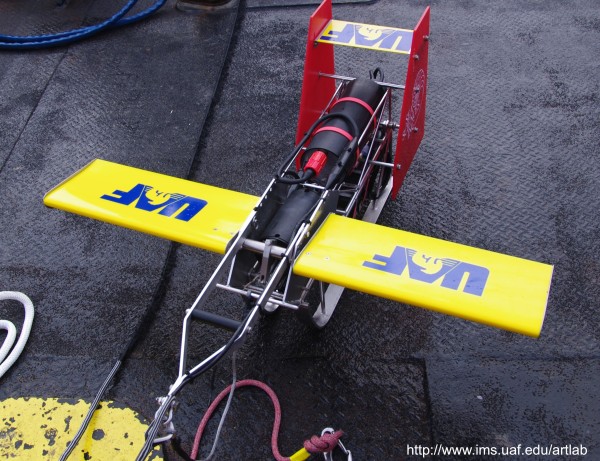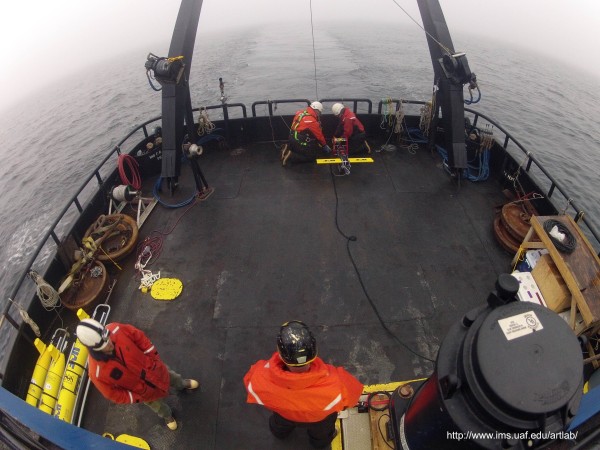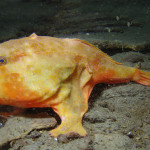The ocean is not homogenous. In other words, not all seawater is the same.
Instead, it made up of many different water masses, each with unique characteristics. These water masses can be adjacent to each other, lay on top of each other like a delicious salty layer cake, or even in very special cases become interleaved where thin fingers of one water mass sneaks its way into another. Not only do these characteristics help us to differentiate water masses, but they also tell us where they came from and how they were formed. I will now describe these water masses using the traditional language of mariners, ALCOHOL!
Every cocktail is made from certain spirits and has a unique taste. Water masses aren’t that different. Where cocktails are classified by ingredients and taste, oceanographers classify water masses by salinity and temperature. Globally, the oceans make an extremely diverse cocktail menu. But in the region of the Chukchi Sea where we are doing our surveys, the selection is rather limited. These are the only three choices on the menu:

- `The Dirty Martini’ – Winter water This is literally the coldest, saltiest seawater around, much like the dirtiest of the Martinis (this also a really apt description of crazy dad Martini). It all starts when seawater freezes in early winter by being supercooled. Unlike freshwater, seawater freezes at lower temperatures due to the excess salt depressing the freshwater freezing point of 0 degrees C (this is why you throw salt on your icy sidewalk) to -1.9 degrees C. As seawater freezes, salt is literally squeezed out of seawater to become pure freshwater ice in a process known as brine rejection. The water at the surface is now super-salty and super-cold (but not quite cold enough to freeze) making it incredibly dense. The water sinks to the bottom of the shallow Chukchi Sea and just sits there, forming what are known as deep cold pools.
- `The Gin and Tonic’ – Meltwater Do you like your drinks light, cold, and refreshing? Meltwater is just that! Just as its name implies, meltwater is formed by melting sea ice. Like sea ice, meltwater is very fresh and very cold, with a temperature hovering around freezing. The freshness also makes meltwater relatively light or buoyant, so it tends to stay floating on the surface above winter water in a very distinct layer. Because we were in the Chukchi in the late summer, right around the end of the summer melt season, we saw a lot of meltwater and a lot of ice that will eventually become meltwater.
- `The Bloody Mary’ – Pacific Water A Bloody Mary feels a little warmer and a little saltier than other drinks, just like Pacific Water. As its name implies, it originates in the Pacific Ocean. Pacific Water is originally cold, but since it is less salty than Winter Water, it is less dense and therefore buoyant, causing it to stay at the surface. As Pacific water winds its way past the Bering Sea, through Bering Strait and into the Chukchi Sea it is slowly warmed by the sun. This makes Pacific Water even lighter and it continues northward hugging the Alaskan coast until eventually it flows into the Arctic Ocean.
To find the unique pockets of temperature and salinity that are these three water masses, we used an instrument we called a Conductivity, Temperature and Depth Sensor. Or as those in the biz call it, the CTD. Oceanographers use a CTD instead of an STD because 1) that acronym has already been taken and 2) we can’t easily measure salinity without some serious chemistry, so we use conductivity, temperature, and depth to calculate salinity instead (check out the ridiculous equation here).
Using a shipboard CTD to sample the ocean is really accurate, but it’s mind-numbingly slow. The ship has to stop. Then the giant metal cage that the CTD is housed in has to be deployed off the side. Then a giant winch lowers it. Then you winch it back up. Then you bring it on board. Then you steam 10 miles to the next station. Rinse. Repeat.
But because the Chukchi Sea is ridiculously shallow, we had another option. We were able to tow our CTD off the back of our ship using an underwater flying research platform, the Acrobat! It is such a neat little piece of equipment. Super small and light, it can be launched off the back of a ship by two normal people or 1 pro-wrestler. We also packed it with a sensor to measure how much chlorophyll and particles are in the water so we can see where the sea beasties are. We found happy phytoplankton all over Pacific Water and squished in a thin layer between in the Winter water just underneath the surface layer of meltwater.


And the raddest part, the staggering amount of data we collected. In 10 days we towed over 1300 kms and made over 4000 profiles. That is nearly 30 times more data than a regular CTD. AWESOME.
I’m actually back on shore now. But my next step is to process this data like a boss. It needs to be cleaned up and wrangled into the right format. The data I showed above is only one snapshot of these water masses. But changing winds and tides causes these water masses to move and possibly mix together. And hopefully the data will show that.






Great post Dr. Martini! Now onto my next refreshing beverage…
Awesome post. Never gave a thought before to how much ocean waters vary. These bodies of waters must be such a huge influence on the sea life present.
Thank you – what a great explanation and very readable. the equation is a bit mind-blowing, though!
Dr. Martini, This is great. When will you put together some more (mixing) recipes?
GREAT…beautiful explanation